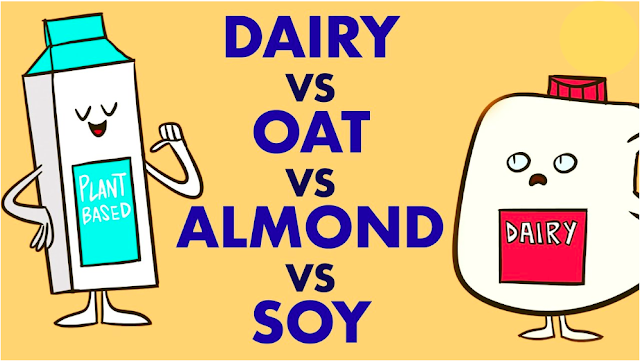Which Type Of Milk Is Best For You
There are a bewildering array of options available whenever you go shopping for milk. Dairy milk is available but so are goods made from plants. A plant needs to be either dried and milled into flour, or it needs to be soaked, drained, rinsed and ground into a thick paste. The plant pastes or flour is then flavour-infused, water-diluted, vitamin and mineral-fortified. The end result is a plethora of choices that have many characteristics with animal milk.
Which milk is therefore best for you in reality?
Let’s examine some of the most widely consumed milks:
Almond, dairy, soy or oat. Depending on whether it is skim, reduced fat or whole milk a 250 ml glass of cow’s milk has 2 to 8 grammes of fat, 8 grammes of protein and 12 grammes of carbs. That amounts to roughly 15% of the daily protein, 10% of the daily carbohydrate and 2% to 15% of the daily fat requirements for an average adult. Compared to dairy milk, most plant-based milks contain fewer carbs. Additionally, they have less fat but more of the so-called “healthy fats.” In contrast, the majority of plant-based milks do not naturally include the beneficial elements calcium and vitamin D that are present in dairy milk. When compared to dairy, our plant-based milks, like almond and oat are low in protein. While oat milk is high in beta-glucans, a beneficial type of fibre, almond milk has the fewest nutrients of the four. In comparison to other plant milks, it also contains a lot of carbohydrates sometimes as many as dairy milk. In contrast, soy milk is a fantastic source of potassium and contains the same amount of protein as cow’s milk. Isoflavone, a substance found in soybeans was once thought to be a possible cause of hormonal abnormalities since it functions similarly to oestrogen. In the end, however, isoflavones which have a far lesser impact on human bodies than oestrogen are present in extremely little quantities in soy milk.
Depending on your specific needs, one of these milks may come out on top:
if you have a lactose intolerance, plant-based milks will win, while almond milk is off limits if you have a nut allergy. Dairy milk may be the most effective source of essential nutrients for persons who lack access to a diverse and varied diet. But if all else is equal, every one of these four milks is wholesome enough to be included in a diet plan. Because of this, many people believe that the milk that is greatest for you is also the milk that is best for the environment. Which then consumes the fewest resources and leaves the least amount of pollution?
One glass of cow’s milk requires roughly 4 square kilometres to produce, a land use that contributes to habitat loss and deforestation. On the majority of that area, cows are kept as livestock, and on some of it, feed is grown. Several cows consume oats and soybeans. Growing the oats or soybeans for milk requires significantly less space than feeding a dairy cow, at around a quarter square kilometre per glass. Similar land use is found in almond milk.
Where that land is used also matters though oat and almond farms don’t contribute significantly to deforestation?
Water is used throughout the entire process of producing milk, however there are significant changes at the agricultural stage. The most water is used by dairy milk, 120 litres each glass, largely to hydrate cows and cultivate their feed. Second rank goes to almonds, which require more than 70 litres of water each glass. Almond trees require years of irrigation before they begin to produce almonds, so the majority of that water is utilised to grow those plants. While many other crops can be left fallow and still produce later, the trees must receive constant watering or they would perish.
In total, only 5 to 10 litres of water per glass of milk are needed to cultivate soy and oats. For plant-based milks, the manufacture of milk results in 0.1 to 0.2 kilos of greenhouse gas emissions per glass. In contrast, cows that make dairy milk also emit enormous amounts of the gas methane when they sneeze and fart. Overall, more than half a kilogram of greenhouse gas emissions are produced by each glass of dairy milk. There is a strong case for choosing plant-based milks, especially oat or soy milk, in terms of the health of our world, even if either of these milks may be a suitable fit for you depending on your dietary needs.
